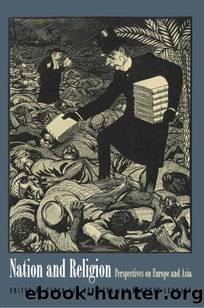Nation and Religion by Peter van der Veer & Hartmut Lehmann

Author:Peter van der Veer & Hartmut Lehmann [Veer, Peter van der & Lehmann, Hartmut]
Language: eng
Format: epub
Publisher: Princeton University Press
Published: 2020-10-05T18:30:00+00:00
Histories of Partition
The fact that the peasantry in eastern Bengal was predominantly Muslim and the landlords largely Hindu has long been regarded by historians, especially Marxist historians, as the crucial structural condition that allowed a class antagonism to be expressed as a conflict between religious groups and that enabled the British to manipulate the various Indian political organizations around this issue. Badruddin Umar, the radical Bangladeshi historian, for instance, states that the partition of Bengal in 1947 âbecame possible because of the presence of certain nonantagonistic contradictions in the country that were converted into antagonistic contradictions by the British rulers.â7 Sugata Bose provides the most carefully researched elaboration of this argument.8 He notes that the Muslim-majority districts of east Bengal consisted of a peasantry that was little differentiated. Until the early decades of the twentieth century, this peasantry had a âsymbiotic relationshipâ with the predominantly Hindu landlords, moneylenders, and traders who supplied the vital needs of credit in a highly monetized agrarian economy. The prolonged depression of the 1930s, however, destroyed these networks of rural credit, leading to âa decisive shift in the balance of class power in [the peasantâs] favour.â The rentier and trading classes
ceased to perform any useful function. Once a political challenge came within the realm of possibility, the strength of a religious identity was exploited in a readily available and, for the privileged co-religionists, a safe ideology. To the vast mass of smallholding peasants living under similar, yet very splintered, conditions of economic existence in east Bengal, religion seemed to impart a sense of âcommunityâ; so at a critical juncture in Bengalâs history, religion provided the basis of a ânational bond,â however stretched, and became the rallying cry of a âpolitical organisationâ demanding the creation of a separate Muslim homeland. Efforts by some Hindu and Muslim leaders to mobilise the Muslim peasantry under the banner of progressive nationalism and socialism proved abortive. Weighed under for decades by an economic, political and moral order they had long ago silently rejected, the Muslim peasantry responded to the appeals of religion and gave a powerful ideological legitimation to a breakdown in social relations that had already occurred, but which was only now being formally conceded.9
Agrarian class conflict erupted in east Bengal in the 1930s. âThis conflict was interpreted and used by self-serving politicians for their own ends. Operating in higher-level political arenas with communal constituencies, the gift of governmentâs successive constitutional reforms, these politicians unflinchingly used religion to mask an essentially economic conflict.â10
While not quite arguing that religion only provided a mask over class conflicts, Suranjan Das nevertheless points out that between the two partitions of Bengal, a significant change in the nature of Hindu-Muslim antagonism occurred.11 After an early period in which they were relatively unorganized, less connected with the institutional politics of parties and legislatures, and strong in class orientation, communal conflicts later showed two kinds of convergences: on one hand, class and communal identities tended to converge, and on the other hand, elite and popular communalism also tended to converge.
Download
This site does not store any files on its server. We only index and link to content provided by other sites. Please contact the content providers to delete copyright contents if any and email us, we'll remove relevant links or contents immediately.
The Lost Art of Listening by Michael P. Nichols(7360)
Why I Am Not A Calvinist by Dr. Peter S. Ruckman(4075)
The Rosicrucians by Christopher McIntosh(3442)
Wicca: a guide for the solitary practitioner by Scott Cunningham(3106)
Signature in the Cell: DNA and the Evidence for Intelligent Design by Stephen C. Meyer(2996)
Real Sex by Lauren F. Winner(2936)
The Holy Spirit by Billy Graham(2837)
To Light a Sacred Flame by Silver RavenWolf(2739)
The End of Faith by Sam Harris(2661)
The Gnostic Gospels by Pagels Elaine(2441)
Waking Up by Sam Harris(2358)
Nine Parts of Desire by Geraldine Brooks(2301)
Jesus by Paul Johnson(2275)
Devil, The by Almond Philip C(2245)
The God delusion by Richard Dawkins(2221)
Heavens on Earth by Michael Shermer(2213)
Kundalini by Gopi Krishna(2118)
Chosen by God by R. C. Sproul(2095)
The Nature of Consciousness by Rupert Spira(2012)
